China then and now
Beijing -- I could feel something was amiss as soon as I started walking down the street in downtown Beijing. No-one was paying any attention to me.
The last time I was here, fifteen years ago, I couldn’t take two steps without getting stares. Now no-one paid me any heed. This is what it must feel like to be a has-been Hollywood star, I thought to myself.
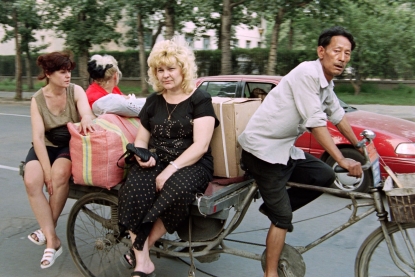 Standing out in a crowd in Beijing -- a Chinese deliveryman rides his flatbed tricycle on a Beijing street, carrying Russian customers and clothes they purchased at the Yabaolu shopping street on June 13, 1995. Lots of people from Russia and former Soviet republics come to Beijing to buy clothes that they can resell back home for a profit. (AFP / Yoshikazu Tsuno)
Standing out in a crowd in Beijing -- a Chinese deliveryman rides his flatbed tricycle on a Beijing street, carrying Russian customers and clothes they purchased at the Yabaolu shopping street on June 13, 1995. Lots of people from Russia and former Soviet republics come to Beijing to buy clothes that they can resell back home for a profit. (AFP / Yoshikazu Tsuno)As Communist China celebrates its 70th anniversary, with the taking stock of what has passed in those seven decades, I look back and marvel at the incredible transformation that the country has undergone since I first stepped foot here in 1993, soon after marrying my Chinese wife, whom I met in London. I returned in 1997 and spent four years working as a reporter for AFP. When I left in 2001, I figured I’d return again for the agency and so I didn’t visit in the interim, so that when I did come back, the changes that had taken place on the ground would take me by surprise. And boy did they.
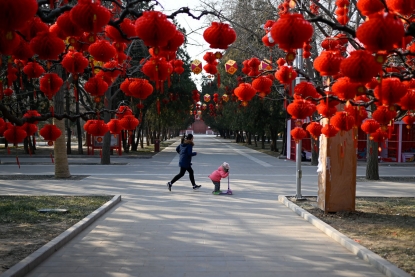 A girl runs with a child standing a scooter past red lanterns ahead of the Chinese Lunar New Year at a park in Beijing on January 24, 2019. (AFP / Wang Zhao)
A girl runs with a child standing a scooter past red lanterns ahead of the Chinese Lunar New Year at a park in Beijing on January 24, 2019. (AFP / Wang Zhao)I left a developing country whose people looked in awe and wonder at the West that was mostly off-limits, a place where personal freedoms were strictly curtailed. I returned to the world’s second-largest economy where people shrug off the West that they visit on vacation, a place where technology is on the cutting edge, but where freedoms are as curtailed as ever.
The scale of change hit me as soon as I took a walk outside the bureau when I returned for my posting in 2016. Before, my European mug would attract stares from passersby. But as I strolled, no-one gave me a second glance. It soon became apparent why.
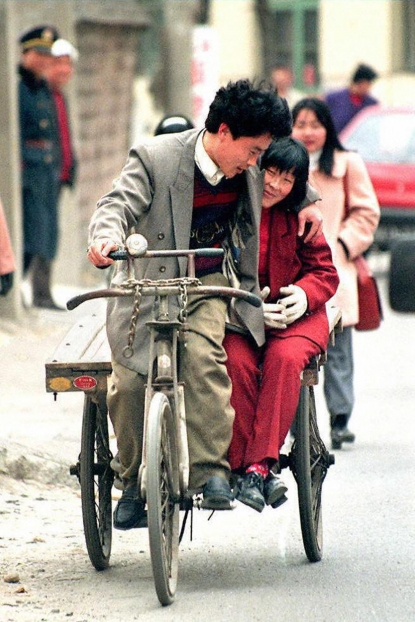 Not getting a second glance -- a couple share some affection while riding a bike in Beijing, March 11, 1997. (AFP / Robyn Beck)
Not getting a second glance -- a couple share some affection while riding a bike in Beijing, March 11, 1997. (AFP / Robyn Beck)Before, the rare European face to walk the streets of Beijing was an exotic creature. All the more so when accompanied by a Chinese wife and three Eurasian offspring. In a land where people were only allowed to have one child, we stood out even more. “You’re allowed to have several children in France?” people often asked me. I never had the heart to tell them that not only were we allowed, we were encouraged to do so, paying less income taxes with each kid.
Back then, a Westerner and a Chinese marrying was so rare that my wife was sometimes taken for the children’s nanny. One time, a woman told her that she shouldn’t hold my hand in public because that wasn’t “a proper thing for an interpreter to do.” Sometimes people would actually follow us in the streets to hear what we were saying to the children. Once an old lady said, “Ah, now this is Chinese! I understood what you just said! I have been listening for an hour, sometimes it was Chinese, sometimes it was a foreign language that I didn’t understand.”
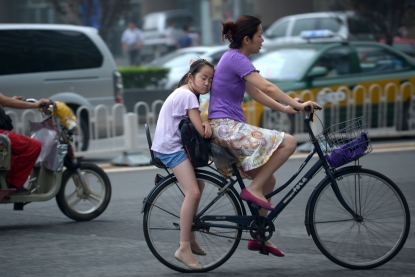 A girl sleeps on the back of a bicycle along a street in Beijing on July 30, 2014. (AFP / Wang Zhao)
A girl sleeps on the back of a bicycle along a street in Beijing on July 30, 2014. (AFP / Wang Zhao)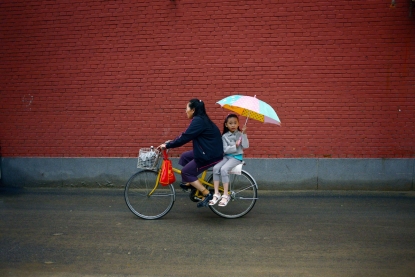 A girl holds an umbrella on the back of a bicycle along a road after school in Beijing on September 2, 2014. (AFP / Wang Zhao)
A girl holds an umbrella on the back of a bicycle along a road after school in Beijing on September 2, 2014. (AFP / Wang Zhao)
But now I walked in solitude, with not so much as a glance in my direction. It soon became apparent why. When I reached the once quiet neighborhood of Sanlitun, I saw veritable hordes of foreigners flitting about between ultra-modern hotels, bars and high-end stores. I was no longer among the few “laowai” (“foreigner”) in Beijing.
Before, all you had to say was a simple “nihao” (“hello”) to get in return a “you speak Chinese so well!” Now, taxi drivers don’t bat an eye if a Westerner speaks their language. And they no longer begin to question him about life in the West, especially his paycheck, as did their predecessors in the 1990s.
Before, there was a reverence for the West and all things Western. Now, I sense a certain disdain. The official media certainly drum in the message that China has nothing more to learn from the West in terms of material well-being, but rather the West has much to learn from China insofar as its system of governance.
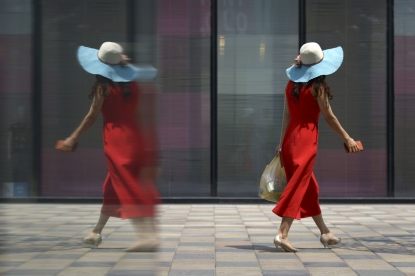 As fashionable as in the West. A woman walks in Beijing, May 20, 2016. (AFP / Wang Zhao)
As fashionable as in the West. A woman walks in Beijing, May 20, 2016. (AFP / Wang Zhao)Some of the changes greeting me I was prepared for -- the record pollution levels, the nightmare traffic jams and a Beijing that has turned into a copy of Manhattan in business neighborhoods. The highest skyscraper when I left at the start of the century now seemed but a babe compared to the buildings shooting into today’s skyline.
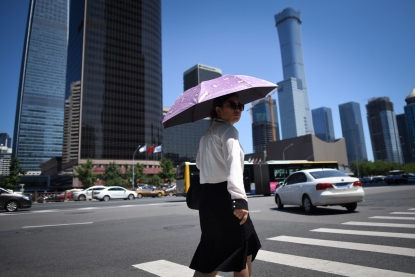 Beijing's business district, July 26, 2018. (AFP / Wang Zhao)
Beijing's business district, July 26, 2018. (AFP / Wang Zhao)What I didn’t expect was the change in how people behaved -- couples who held hands in public; young people kissing in the open; retirees walking their dogs -- all of these would have been labeled “bourgeois” and thus forbidden not that long ago.
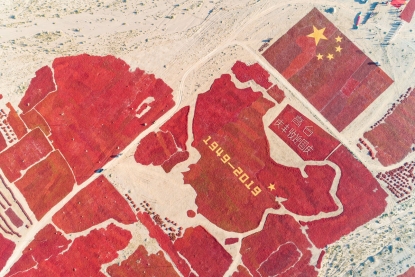 This aerial photo taken on September 23, 2019 shows the image of a Chinese map and a national flag formed by dried chili peppers during the harvest season in Zhangye in China's northwestern Gansu province, as farmers celebrate the 70th anniversary of the founding of the People's Republic of China. (AFP / Stringer)
This aerial photo taken on September 23, 2019 shows the image of a Chinese map and a national flag formed by dried chili peppers during the harvest season in Zhangye in China's northwestern Gansu province, as farmers celebrate the 70th anniversary of the founding of the People's Republic of China. (AFP / Stringer)Some of the changes have been especially striking in the country, which has seen its gross national product double over the past 10 years.
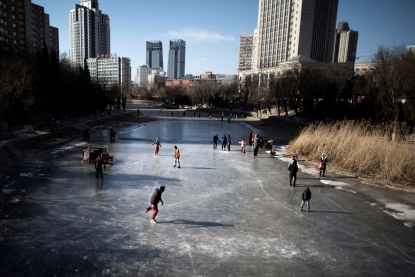 Skating into prosperity -- people ice skate on a frozen river in Beijing, January 21, 2017. (AFP / Fred Dufour)
Skating into prosperity -- people ice skate on a frozen river in Beijing, January 21, 2017. (AFP / Fred Dufour)When I first landed in Beijing in 1993, the airport was a Soviet-style behemoth. You drove into the city on a lovely highway running through the countryside, framed by weeping willows. The feeling was of a developing country, from the state of the roads, to the cars driving on them.
Today the airport has three terminals and the highway leading to it is constantly jammed with traffic both ways. A second airport has just opened in the south of the capital and like many things here it’s destined to become “the largest in the world.”
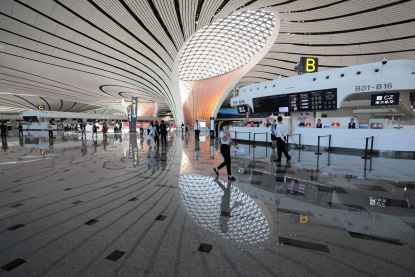 People walk inside the new Beijing Daxing International Airport during its first day of operation in Beijing on September 25, 2019. (AFP / Str)
People walk inside the new Beijing Daxing International Airport during its first day of operation in Beijing on September 25, 2019. (AFP / Str)Beijing, which counts 21 million residents, is today encircled by five ring roads, two more than when I left in 2001. The last one built is more than 200 kilometers long.
 If you build it, they will come -- traffic in a ring road in the central business district in Beijing, March 21, 2019. (AFP / Fred Dufour)
If you build it, they will come -- traffic in a ring road in the central business district in Beijing, March 21, 2019. (AFP / Fred Dufour)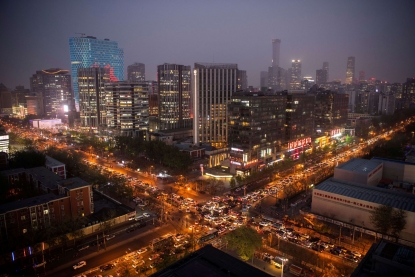 ...by day or night -- a traffic jam in central Beijing, April 16, 2018. (AFP / Fred Dufour)
...by day or night -- a traffic jam in central Beijing, April 16, 2018. (AFP / Fred Dufour)
Public transport has exploded. When I left there were two metro lines. Today, there are around 20, most of them built in time for the 2008 Olympic Games.
Want to leave the capital? The world’s largest network of high-speed trains is at your disposition. Today I can get to Shanghai in four and a half hours -- before it would take more than 20.
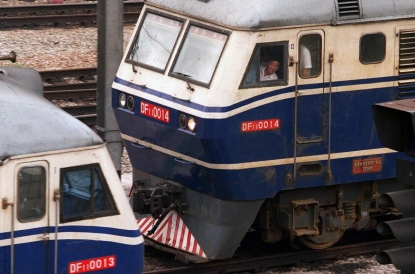 The driver of the first direct express passenger train between Shanghai and Hong Kong smiles as he pulls into Kowloon station, May 12, 1997. (AFP / Peter Parks)
The driver of the first direct express passenger train between Shanghai and Hong Kong smiles as he pulls into Kowloon station, May 12, 1997. (AFP / Peter Parks)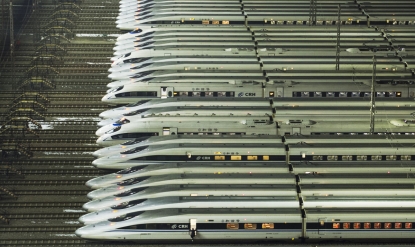 High speed trains at a service center in Wuban in China's central Hubei province, early on February 1, 2018, ahead of the annual migration rush for the Lunar New Year. (AFP / )
High speed trains at a service center in Wuban in China's central Hubei province, early on February 1, 2018, ahead of the annual migration rush for the Lunar New Year. (AFP / )
And cars? Well, suffice it to say that when I drive AFP’s Peugeot in the streets of Beijing, I sometimes feel overwhelmed by the number of Ferraris, Lamborghinis, Maseratis and other luxury models parading around Sanlintun, especially at night when the nouveux riches enjoy a party out. It sometimes looks like you’re a failure if you don’t have at least a Porsche at 25.
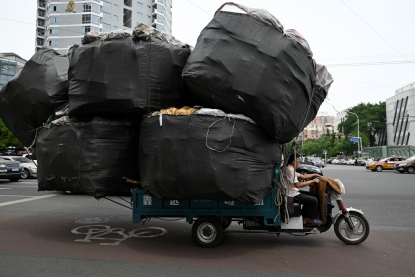 Not a Porsche, but electric -- A man rides an electric tricycle loaded with goods on a street in Beijing on June 5, 2019. (AFP / Wang Zhao)
Not a Porsche, but electric -- A man rides an electric tricycle loaded with goods on a street in Beijing on June 5, 2019. (AFP / Wang Zhao)Before, only a handful of countries were officially designated as “tourist destinations” that the Chinese were allowed to visit. Today, hordes of Chinese tourists are a ubiquitous presence at the world’s major attractions, from the Statue of Liberty in New York, to the Eiffel Tower in Paris, to the Machu Picchu in Peru.
The change was crystallized for me when I went into the office early recently and ran into our cleaning woman, Mrs. Wang, who had just returned from a week off.
“How was your vacation Mrs. Wang,” I asked.
“It was great, I was in Spain,” she answered.
“Where?” I asked, thinking that I misunderstood the word she used.
“Spain,” she answered, leaving me a bit stupefied -- 20 years ago a cleaning woman jetting over to Spain for a week was unthinkable. It remains to be seen if this openness to the world will lead to an openness of ideas and information.
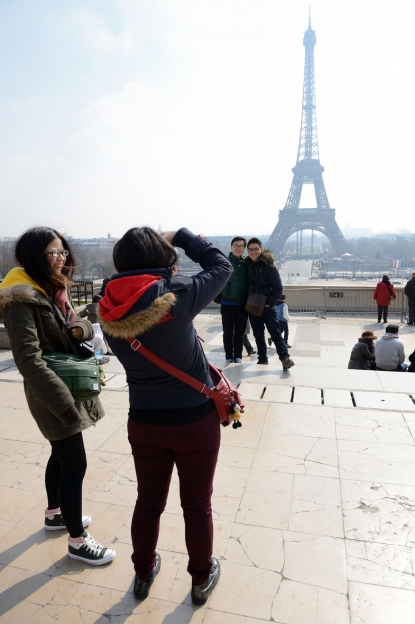 Chinese tourists in Paris, March 27, 2013.
(AFP / Eric Feferberg)
Chinese tourists in Paris, March 27, 2013.
(AFP / Eric Feferberg) Chinese tourists in Moscow, February 29, 2012. (AFP / John Macdougall)
Chinese tourists in Moscow, February 29, 2012. (AFP / John Macdougall)
The use of technology has exploded as well. The first time I came, it was nearly impossible to use a credit card here. The only way to get cash was to stand in line in Bank of China’s sole teller window in Beijing dedicated to the service.
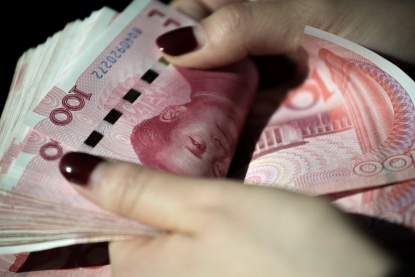 Chinese 100 yuan notes in Beijing, February, 2017. (AFP / Fred Dufour)
Chinese 100 yuan notes in Beijing, February, 2017. (AFP / Fred Dufour)Back then, there were two forms of money -- “renminbi,” or “people’s money” that was used by everyone, and “Foreign Exchange Certificate” (FEC), which foreigners were required to use and which cost quite a bit more. To get into tourist sites, not only were you required to use FEC, but also pay an entrance fee that was much higher than that for the Chinese visitors. I once tried to defy this system by sneaking into the Forbidden City under an enormous straw hat. It didn’t fool anyone and I had to cough up the foreigner’s price.
Today the FEC is gone and I pay for nearly everything with my smartphone. In one of the last village markets in the capital, I pay for my onions with the WeChat app, omnipresent in the country, by scanning the seller’s QR code with my phone.
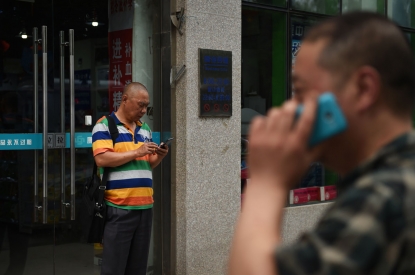 Smartphones everywhere -- Beijing, June 20, 2016.
(AFP / Greg Baker)
Smartphones everywhere -- Beijing, June 20, 2016.
(AFP / Greg Baker)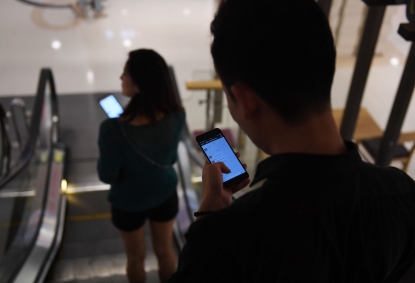 Smartphones everywhere -- on an escalator in Beijing, July 15, 2016. (AFP / Greg Baker)
Smartphones everywhere -- on an escalator in Beijing, July 15, 2016. (AFP / Greg Baker)
What hasn’t changed is the government’s grip on information that their citizens can have access to. Sites like Facebook, Google and Twitter are blocked, as well as any other information that the government considers subversive. And therein lies the paradox of today’s China -- on the one hand, you are in a country that is as developed, if not more so, than the West. On the other hand, politically, it remains stuck in the same structures that were established in 1949, when Mao Zedong proclaimed the founding of the People’s Republic of China.
If anything the regime’s authoritarian nature has been hardened under the rule of President Xi Jinping, in power since 2012. The daily ritual of the 7:00 pm news broadcast on state television remains the same -- the same decor, sometimes even the same anchors from 20 years ago. And the content? As a student friend of mine put it: “A third is dedicated to showing how formidable our leaders are, a third to showing how great our country is and a third to pointing out how bad it is abroad.”
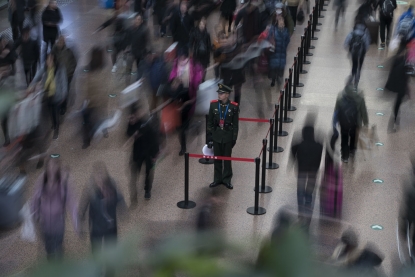 Watching you -- A Chinese soldier watches as travelers rush through the main hall of the West Railway Station in Beijing, February 10, 2018.
(AFP / Fred Dufour)
Watching you -- A Chinese soldier watches as travelers rush through the main hall of the West Railway Station in Beijing, February 10, 2018.
(AFP / Fred Dufour)But if before the airtime was divided between the country’s leaders -- the president was allotted five minutes at the start of the broadcast, the prime minister three minutes, followed by others. Today it’s all Xi Jinping all the time. Sometimes the news channels don’t even bother showing him speak, they just run images of crowds enthusiastically applauding their wise, beloved leader.
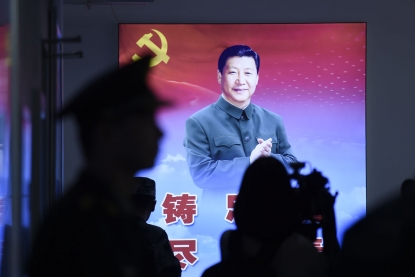 Xi Jinping everywhere. Outskirts of Beijing, September 25, 2019. (AFP / Wang Zhao)
Xi Jinping everywhere. Outskirts of Beijing, September 25, 2019. (AFP / Wang Zhao)Another thing that hasn’t changed is the distrust of the foreign media. One day I saw a young couple with two small children in Beijing and we began talking about the difficulties of raising kids in the world’s most populous nation. It was 2016, just three years after China abolished its long-standing one-child policy, and seeing people with multiple offspring was still quite rare. After a few minutes of amicable chit-chat, I mentioned that I was a foreign journalist and would love to interview them as part of a larger story on couples with multiple children.
You should have seen the woman’s face change at the mention of “foreign journalist.” It was like she had seen a ghost. She quickly buckled her two cherubs into her immaculate SUV and took off. I would have thought that with all the changes, the fear of speaking to foreign media would have dissipated somewhat, especially among the educated, middle class like this particular couple. But some habits in Communist China are hard to break. If anything, over the past three years I’ve found that the fear of the authorities often is even more entrenched.
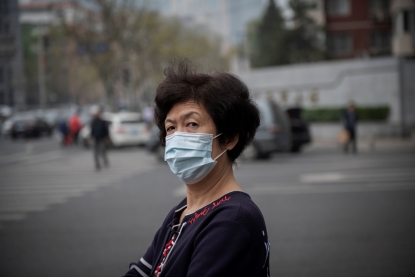 Beijing, April 23, 2019. (AFP / Nicolas Asfouri)
Beijing, April 23, 2019. (AFP / Nicolas Asfouri)A trip to southern China for a feature showed me why.
First, I have to say that there has been a slight improvement in how foreign media can operate in the country -- we can now go everywhere but Tibet without first receiving permission from the local authorities (Tibet being the sole exception).
That said, plenty of obstacles and tools of control still remain -- our press passes are valid for just one year and we have to show our visas in trains, airports and hotels, which immediately signals our presence to the local authorities, who often put obstacles in our way. During that trip to southern China, just before the election of Donald Trump as US president, one of our teams went to do a story on a factory that was manufacturing clothes for his daughter Ivanka’s clothing line.
The factory owner was very open, allowing our reporters great access, including taking photos of the workers’ dormitory at night. We ended up with a very nice story. Then, a few months later, an English-language official newspaper accused us of wanting to give the country a bad image. The reason? The dormitory photos that it alleged were “stolen” and that according to the daily gave a dickensian image of the factory. The author of the article didn’t contact the bureau for a comment and when we wrote to ask to have our version, we received no reply.
But the most worrying thing was that the article in the official daily said that measures had been taken against people for having cooperated with the AFP team. The message was clear -- do not speak to foreign reporters. Is it any wonder that with such “hints” a young mother would be terrified to speak to me about a harmless lifestyle story?
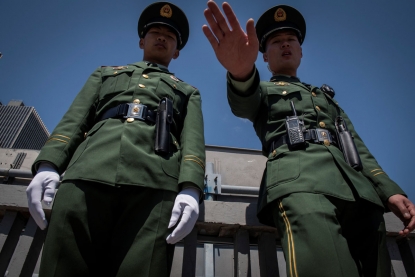 Media not welcome -- two paramilitary police officers secure an area along a street during the Belt and Road Forum in Beijing on April 25, 2019. (AFP / Nicolas Asfouri)
Media not welcome -- two paramilitary police officers secure an area along a street during the Belt and Road Forum in Beijing on April 25, 2019. (AFP / Nicolas Asfouri)When people ask me what it’s like to live and work this time around in China, I answer that it’s much easier, but not nearly as fun as before. But despite the daily professional frustrations, I remain fascinated by the place. And the work of foreign media becomes all the more important in a country where the domestic press is severely hampered -- it’s up to us to try to extract reality from the official line. A handful of us for a population of more than one billion...
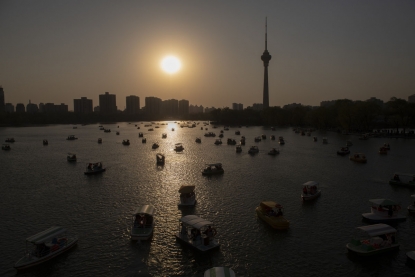 People enjoy sunset boat rides in the Yuyuantan park in Beijing, March 24, 2019.
(AFP / Nicolas Asfouri)
People enjoy sunset boat rides in the Yuyuantan park in Beijing, March 24, 2019.
(AFP / Nicolas Asfouri)


